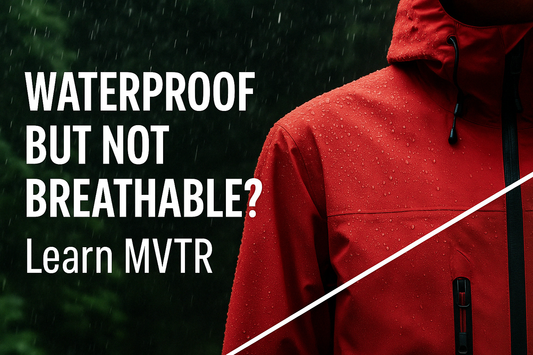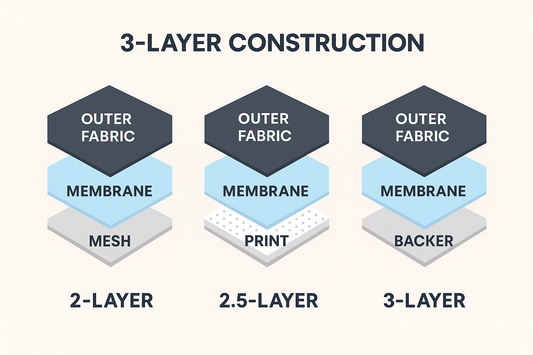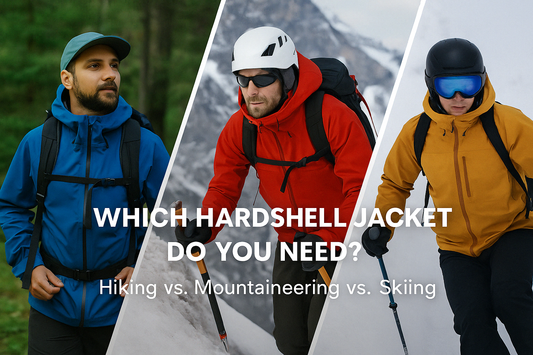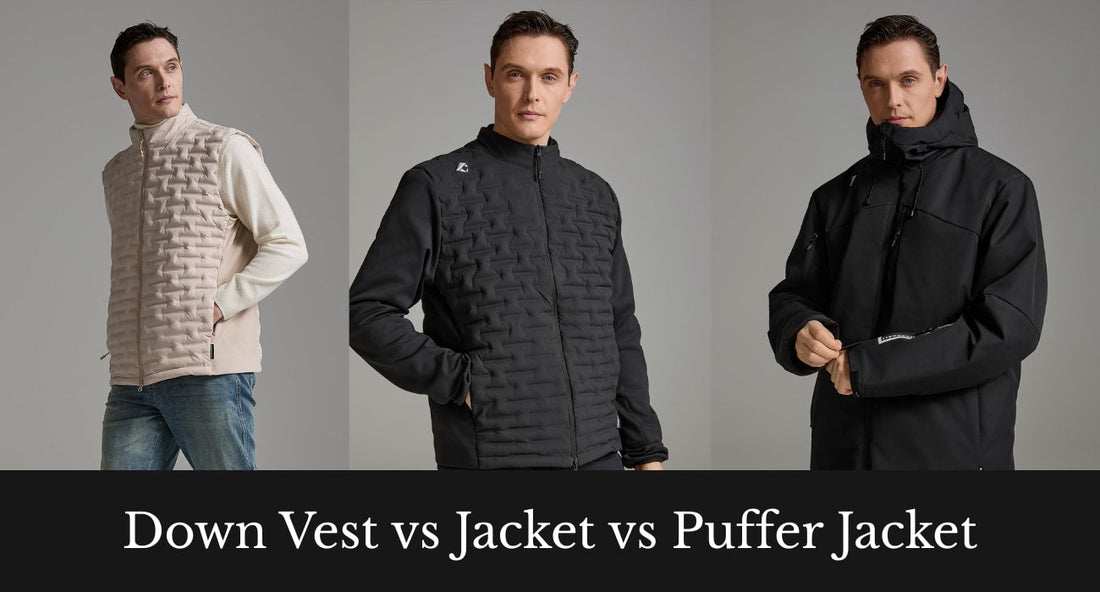
Down Vest vs Jacket vs Puffer Jacket: Which Is Best for Winter?
Share
Whether you’re braving freezing temperatures on a hike, navigating chilly city streets, or layering up for outdoor adventures, your gear needs to work for you. But with so many options—down vests, jackets, and puffer jackets—how do you decide which one is best for your needs?
In this guide, we’ll break down the pros and cons of each option to help you choose the perfect outerwear that keeps you warm, comfortable, and ready for whatever the season throws at you. Keep reading to find the ideal fit for your lifestyle and activities.
Down Vest vs Jacket vs Puffer Jacket in Pros & Cons
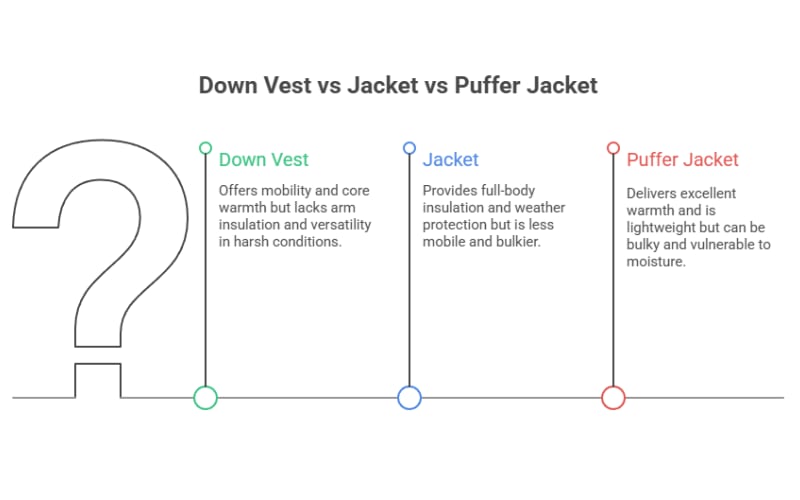
Choosing between a down vest, a jacket, and a puffer jacket can impact both your comfort and style. Each has its own benefits, and knowing when to wear each will help you stay warm without overpacking. Let's take a look at the pros and cons of each option.
Down Vest
A down vest is all about keeping your core warm while leaving your arms free to move. It's perfect for layering and great when you're on the move. The absence of sleeves gives you more freedom to move, making it ideal for activities where you're using your arms a lot, like hiking, running, or chopping wood.
Pros:
-
Great mobility: No sleeves means no restrictions on your arms, which is a plus for active activities.
-
Lightweight: Vests are generally lighter and more compact, making them easy to pack or layer with other pieces.
-
Core warmth: Focuses insulation on your torso, which is where your body loses the most heat, helping to keep you warm without overheating.
Cons:
-
No arm insulation: While your core stays warm, your arms can feel the cold, especially in windy or extremely low temperatures.
-
Less versatile in harsh conditions: A vest alone won’t cut it if you're facing freezing temperatures or harsh winds. It works best as part of a layering system.
Jacket
A jacket is a classic winter outerwear choice, offering full coverage for both your torso and arms. Jackets provide a more comprehensive solution for staying warm, especially in wind or rain. Whether it's a down jacket or a synthetic one, jackets are great for situations where you're stationary or moving at a slower pace.
Pros:
-
Full-body insulation: Keeps both your torso and arms warm, making it the better option for cold, windy days.
-
Versatility: Can be worn alone or layered with other pieces, making it adaptable to various conditions.
-
Weather protection: A good jacket often comes with added features like water resistance or windproofing, which can be crucial in harsh winter conditions.
Cons:
-
Less mobility: The full sleeves can restrict movement, especially if you're doing something that requires arm flexibility, like climbing or even carrying a backpack.
-
Bulkier: Jackets tend to be bulkier and take up more space in your bag. They also trap heat more easily, which can lead to overheating if you’re very active.
Puffer Jacket
Puffer jackets are designed to provide maximum warmth through their quilted, down-filled construction. They’re known for their insulation properties, especially in extremely cold weather. Think of a puffer as a jacket with a high-performance insulation system, making it a top choice for colder climates.
Pros:
-
Excellent warmth: Puffer jackets trap heat incredibly well thanks to their down or synthetic fill. They are perfect for staying warm in freezing temperatures.
-
Lightweight for the warmth: Despite being warm, modern puffers are often surprisingly lightweight due to advanced insulation technology.
-
Compactable: Many puffer jackets are packable, so you can compress them down for easy storage when you’re not wearing them.
Cons:
-
Can be bulky: Some puffer jackets can be quite puffy, which makes them less flattering and can feel heavy if you need to wear it all day.
-
Less breathable: While great at trapping warmth, they can make you overheat quickly if you’re engaging in high-intensity activities or moving too much.
-
Vulnerability to moisture: Down-filled puffers lose their insulating power when wet, so a waterproof shell or a synthetic option is needed for rainy or snowy conditions.
Down Vest vs Jacket vs Puffer Jacket
|
Feature |
Down Vest |
Jacket |
Puffer Jacket |
|
Warmth Coverage |
Core only, arms exposed | Torso and arms insulated | Full coverage of torso and arms |
|
Temperature Range |
Best for 35°F (1°C) to 50°F (10°C) | Best for 30°F (-1°C) to 50°F (10°C) | Best for 20°F (-6°C) and lower |
|
Mobility & Venting |
Excellent mobility, good venting | Moderate mobility, limited venting | Limited mobility, minimal venting |
|
Wind Resistance |
Minimal wind resistance | Good wind resistance | Excellent wind resistance |
|
Packability & Weight |
Lightest, most packable | Heavier, bulkier | Lightweight but bulkier, still packable |
|
Best Use |
Active use, mild-to-cool weather | Everyday wear, moderate winter | Extreme cold, low activity or stationary use |
Is a vest warmer than a jacket?
Generally, no. A jacket provides more complete warmth since it covers both your torso and arms. A vest only insulates your core, leaving your arms exposed, which can be less effective in cold or windy conditions.
Can I wear a vest instead of a jacket?
Yes, but it depends on the conditions. A vest is great for active use in cool to mild weather, as it allows for more freedom of movement. However, if you need full warmth and protection from the cold or wind, a jacket is a better option.
Vest vs Jacket for Hiking
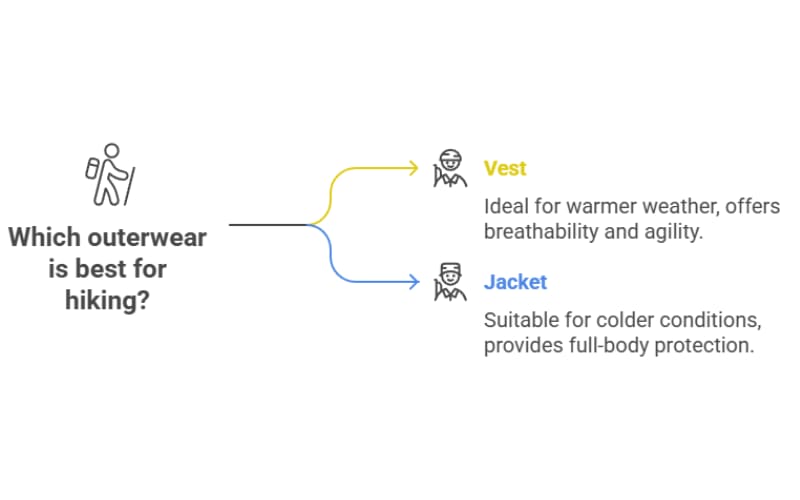
When choosing between vests and jackets for hiking, it mostly depends on the weather and the intensity of the activity.
Vest for Hiking
A vest is ideal for warmer or fluctuating weather. It keeps you light and agile during your hike, as it doesn’t restrict arm movement, which is especially useful if you’re climbing or need to stretch frequently. Since it’s sleeveless, it also offers better breathability, preventing overheating during high-intensity hikes.
Jacket for Hiking
On the other hand, a jacket is more suitable for colder conditions, particularly when it's windy or rainy. It provides full-body protection, keeping you warm and dry. Jackets are especially beneficial if the weather is unpredictable or if you're hiking in colder temperatures, offering more insulation than a vest.
The Best of Both Worlds: Layering
For the most flexibility, layering a vest and jacket together is a great solution. On an active hike, start with a vest to stay light and mobile. As the temperature drops or you slow down, simply add a jacket for extra warmth and protection. Layering allows you to adapt to changing conditions, providing you with the right amount of insulation when you need it.
When to Wear a Vest Without a Jacket?
A down vest is ideal for high-intensity activities in cool weather or as a mid-layer in colder conditions. Works well when you need freedom of movement and don’t need full warmth for your arms.
Best for: Hiking, running, cycling, or layering on a cooler day.
Warm Vests Recommended: Graphene Vest
Tired of the bulk and discomfort of traditional down vests? The Graphene Vest offers a whole new wearing experience, turning your winter from a burden into a season of comfort and ease.
Why You’ll Love It
-
Exceptional Warmth, No More Cold: Thanks to graphene technology, it locks in more heat, keeping you warm in chilly weather without the need for heavy layers.
-
Stay Dry and Cool, No More Stuffy Feeling: The graphene fabric quickly absorbs moisture and wicks it away, keeping you dry during your hike, run, or cycling session. No more uncomfortable chills after exertion..
-
All-Day Comfort with Antibacterial Properties: The graphene lining isn’t just warm — it’s antibacterial, reducing odors and bacteria from sweat. You’ll stay fresh and comfortable, even after long hours of wear.
- Lightweight Freedom of Movement: Its lightweight design promotes excellent mobility, so you can enjoy unrestricted movement whether you're biking, running, or simply layering it under a light jacket or windbreaker in cooler weather.
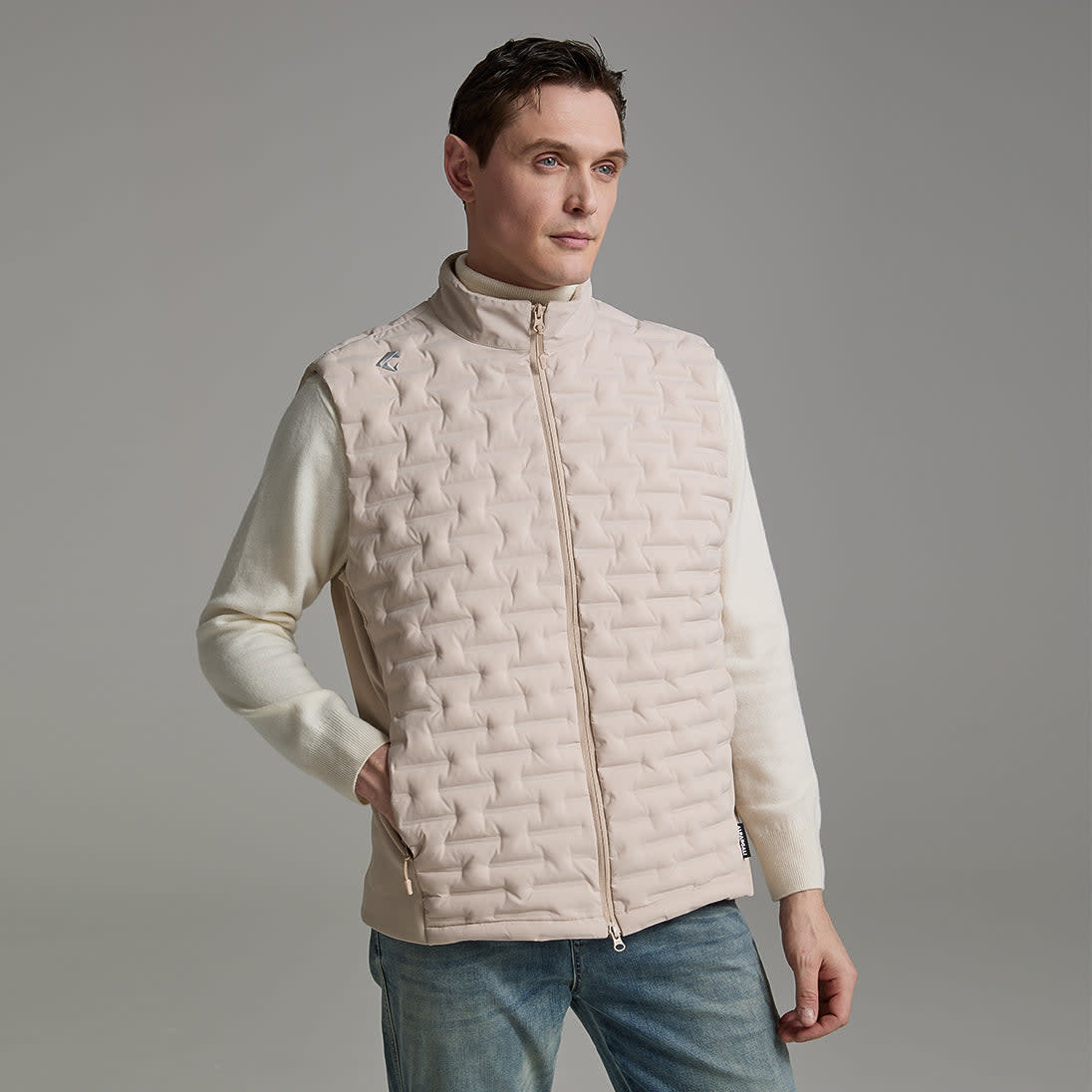
When a Jacket Makes More Sense?
The jacket is ideal for moderate winter conditions when you need full body warmth and flexibility for both active and passive use. It’s great for everyday wear and layering during colder weather.
Best for: Daily activities, moderate temperatures, or layering during winter.
Jackets Recommended: Graphene Lightweight Jacket
Winter doesn’t have to mean bulky jackets and discomfort. With the Graphene Lightweight Jacket, you can stay warm, dry, and stylish all day long—whether you're on the move in the city or enjoying the great outdoors.
Why You’ll Love It:
-
Graphene-Powered Warmth: Say goodbye to cold, heavy layers. The graphene back panel locks in heat where you need it, giving you maximum warmth without the extra weight. Perfect for the chillier months.
-
Light & Cozy: Made with Sorona® insulation, this jacket provides the perfect warmth-to-weight ratio. You’ll stay cozy, but never feel weighed down.
-
Ready for Anything: Whether it’s drizzling rain or muddy paths, the Teflon™ coating keeps the elements at bay, making this jacket water- and stain-resistant—so you look fresh no matter the weather.
-
Versatile & Stylish: Need a quick, sleek look for your commute? This jacket’s minimalist style fits seamlessly into city life. Want more warmth? Layer it under a heavier coat during colder days. Versatility meets style.
- Practical Pockets: With 3 zippered pockets, there’s plenty of space to keep your essentials safe and secure.
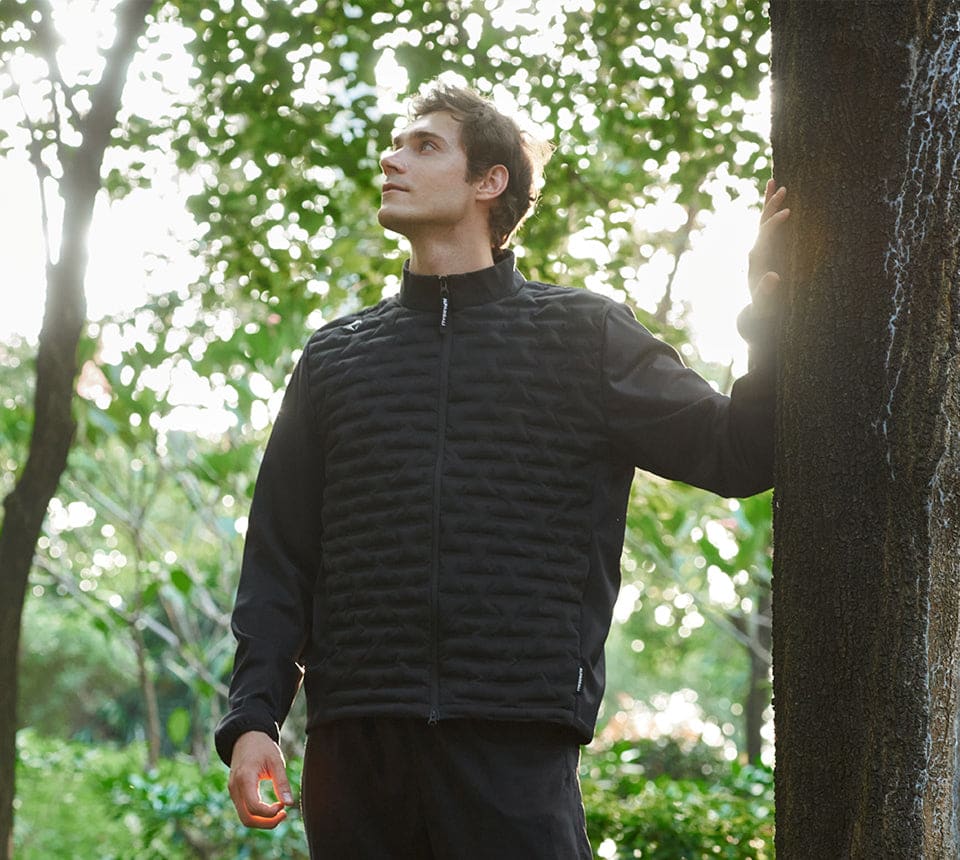
When a Puffer Jacket Makes More Sense?
Puffer Jacket is perfect for extreme cold, low activity, or stationary use. The puffer is designed to lock in maximum warmth, so it’s ideal when you're staying still or in extremely cold environments.
Best for: Minimal movement, extreme cold, sitting still in harsh weather (e.g., camping in the snow).
Puffer Jackets Recommended: Alpargali Aerogel Graphene Puffer Jacket
Bulky coats limit your movement and leave you sweating indoors. The Alpargali Aerogel Graphene Puffer Jacket is exactly different.
For those freezing days when you need to be outside for hours, or the wet and snowy weather that just won’t quit, this jacket gives you maximum warmth without the extra weight. Whether you're out on a winter hike, commuting in the city, or traveling, it adapts to every need without sacrificing style or comfort.
-
Stay Warm in Sub-Zero Temperatures: No more freezing on your commute or outdoor adventures. This jacket keeps you warm down to -40°F—no heavy layers needed.
-
Lightweight & Breathable: Hate feeling weighed down? This jacket is incredibly warm without the bulk, so you can move freely and comfortably.
-
Weatherproof for Every Situation: Whether it’s rain, snow, or wind, stay dry and comfortable all day with a waterproof, windproof design.
- All-Day Comfort & Function: With 9 pockets for everything from keys to gloves, and breathable vents to keep you comfortable, you’ll feel ready to take on whatever winter throws at you.
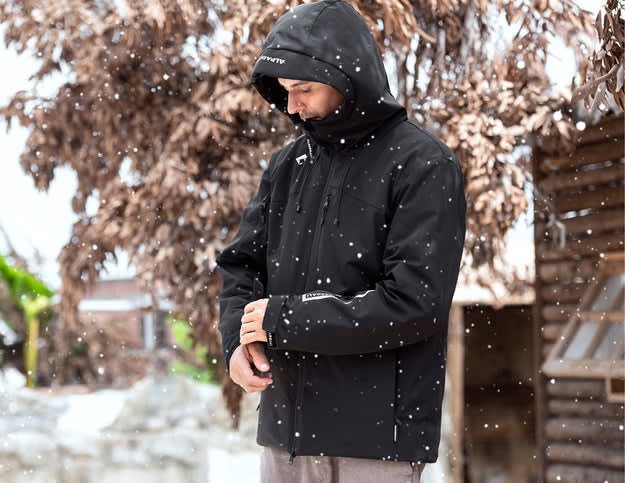
Choosing the Right Gear for Your Activity
Travel & Indoor-Outdoor Switching: If you're transitioning between indoors and outdoors, opt for a packable down vest or lightweight jacket that can easily be layered.
Dry Cold vs. Wet Cold:
-
Dry Cold: Down vests or puffer jackets are great for dry, cold weather as they provide excellent insulation.
- Wet Cold: Choose synthetic jackets for wet conditions, as they retain warmth even when damp.
Ready to Find Your Perfect Winter Gear?
Choosing the right outerwear is key to staying comfortable, no matter what the weather throws at you. Whether you're after the lightweight freedom of a down vest, the versatile warmth of a jacket, or the ultimate cold protection of a puffer, we have the perfect solution for you.
At Alpargali, we’re committed to helping you find the ideal gear for every adventure. Visit our Clothing Comparison page now to explore detailed insights, compare options, and find the perfect fit for your needs.
Don't wait—gear up with us and experience the winter like never before!
FAQs
Which is Warmer with the Same Fill: Down Vest, Jacket, or Puffer Jacket?
With the same amount of fill, a puffer jacket is generally warmer than a down vest or a jacket. This is because it covers both your torso and arms, trapping more heat. A down vest only insulates your core, leaving your arms exposed, while a jacket offers full coverage but may not be as warm as a puffer.
Is a Down Vest Enough for 10°F (-12°C)?
No, a down vest alone isn’t enough for 10°F (-12°C). It provides core warmth but leaves your arms exposed, which can result in feeling cold, especially if it's windy. You'll need additional layers or a jacket to stay warm in such cold temperatures.
Does Dampness or Sweat Make Down Lose Its Warmth?
Yes, dampness or sweat can cause down to lose its insulating properties. When down gets wet, it loses its loft and doesn’t trap heat effectively. For wet conditions, synthetic fills are a better choice, as they retain warmth even when damp.
Does Sewn Construction Affect Warmth?
Yes. Sewn-through is lighter and thinner, may have cold spots, and is suitable for mild to moderate cold. Baffled is more uniform and warmer, suitable for colder temperatures, but weighs more and costs more.
Why Do Bikers Wear Vests Instead of Jackets?
Bikers wear vests because they provide greater freedom of movement for the arms, which is essential for handling the bike. Vests are also lighter and more breathable, making them a better option for long rides or in moderate weather conditions.
